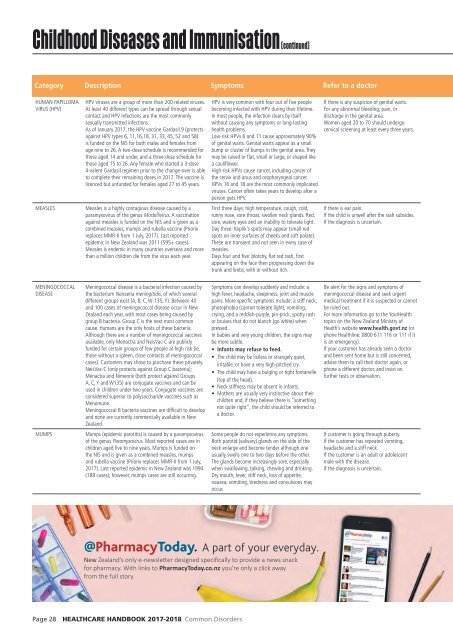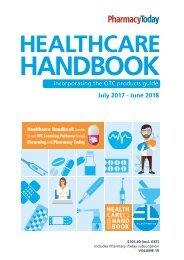2017 HCHB_digital
You also want an ePaper? Increase the reach of your titles
YUMPU automatically turns print PDFs into web optimized ePapers that Google loves.
Childhood Diseases and Immunisation (continued)<br />
Category Description Symptoms Refer to a doctor<br />
HUMAN PAPILLOMA<br />
VIRUS (HPV)<br />
HPV viruses are a group of more than 200 related viruses.<br />
At least 40 different types can be spread through sexual<br />
contact and HPV infections are the most commonly<br />
sexually transmitted infections.<br />
As of January <strong>2017</strong>, the HPV vaccine Gardasil 9 (protects<br />
against HPV types 6, 11,16,18, 31, 33, 45, 52 and 58)<br />
is funded on the NIS for both males and females from<br />
age nine to 26. A two-dose schedule is recommended for<br />
those aged 14 and under, and a three-dose schedule for<br />
those aged 15 to 26. Any female who started a 3-dose<br />
4-valent Gardasil regimen prior to the change-over is able<br />
to complete their remaining doses in <strong>2017</strong>. The vaccine is<br />
licenced but unfunded for females aged 27 to 45 years.<br />
HPV is very common with four out of five people<br />
becoming infected with HPV during their lifetime.<br />
In most people, the infection clears by itself<br />
without causing any symptoms or long-lasting<br />
health problems.<br />
Low-risk HPVs 6 and 11 cause approximately 90%<br />
of genital warts. Genital warts appear as a small<br />
bump or cluster of bumps in the genital area. They<br />
may be raised or flat, small or large, or shaped like<br />
a cauliflower.<br />
High-risk HPVs cause cancer, including cancer of<br />
the cervix and anus and oropharyngeal cancer.<br />
HPVs 16 and 18 are the most commonly implicated<br />
viruses. Cancer often takes years to develop after a<br />
person gets HPV.<br />
If there is any suspicion of genital warts.<br />
For any abnormal bleeding, pain, or<br />
discharge in the genital area.<br />
Women aged 20 to 70 should undergo<br />
cervical screening at least every three years.<br />
MEASLES<br />
Measles is a highly contagious disease caused by a<br />
paramyxovirus of the genus Morbillivirus. A vaccination<br />
against measles is funded on the NIS and is given as a<br />
combined measles, mumps and rubella vaccine (Priorix<br />
replaces MMR-II from 1 July, <strong>2017</strong>). Last reported<br />
epidemic in New Zealand was 2011 (595+ cases).<br />
Measles is endemic in many countries overseas and more<br />
than a million children die from the virus each year.<br />
First three days: high temperature, cough, cold,<br />
runny nose, sore throat, swollen neck glands. Red,<br />
sore, watery eyes and an inability to tolerate light.<br />
Day three: Koplik’s spots may appear (small red<br />
spots on inner surfaces of cheeks and soft palate).<br />
These are transient and not seen in every case of<br />
measles.<br />
Days four and five: blotchy, flat red rash, first<br />
appearing on the face then progressing down the<br />
trunk and limbs, with or without itch.<br />
If there is ear pain.<br />
If the child is unwell after the rash subsides.<br />
If the diagnosis is uncertain.<br />
MENINGOCOCCAL<br />
DISEASE<br />
Meningococcal disease is a bacterial infection caused by<br />
the bacterium Neisseria meningitidis, of which several<br />
different groups exist (A, B, C, W-135, Y). Between 40<br />
and 100 cases of meningococcal disease occur in New<br />
Zealand each year, with most cases being caused by<br />
group B bacteria. Group C is the next most common<br />
cause. Humans are the only hosts of these bacteria.<br />
Although there are a number of meningococcal vaccines<br />
available, only Menactra and NeisVac-C are publicly<br />
funded for certain groups of few people at high risk (ie,<br />
those without a spleen, close contacts of meningococcal<br />
cases). Customers may chose to purchase these privately.<br />
NeisVac-C (only protects against Group C bacteria);<br />
Menactra and Nimenrix (both protect against Groups<br />
A, C, Y and W135) are conjugate vaccines and can be<br />
used in children under two years. Conjugate vaccines are<br />
considered superior to polysaccharide vaccines such as<br />
Menomune.<br />
Meningococcal B bacteria vaccines are difficult to develop<br />
and none are currently commercially available in New<br />
Zealand.<br />
Symptoms can develop suddenly and include: a<br />
high fever, headache, sleepiness, joint and muscle<br />
pains. More specific symptoms include: a stiff neck,<br />
photophobia (cannot tolerate light), vomiting,<br />
crying, and a reddish-purple, pin-prick, spotty rash<br />
or bruises that do not blanch (go white) when<br />
pressed.<br />
In babies and very young children, the signs may<br />
be more subtle.<br />
• Infants may refuse to feed.<br />
• The child may be listless or strangely quiet,<br />
irritable, or have a very high-pitched cry.<br />
• The child may have a bulging or tight fontanelle<br />
(top of the head).<br />
• Neck stiffness may be absent in infants.<br />
• Mothers are usually very instinctive about their<br />
children and, if they believe there is “something<br />
not quite right”, the child should be referred to<br />
a doctor.<br />
Be alert for the signs and symptoms of<br />
meningococcal disease and seek urgent<br />
medical treatment if it is suspected or cannot<br />
be ruled out.<br />
For more information go to the YourHealth<br />
topics on the New Zealand Ministry of<br />
Health’s website www.health.govt.nz (or<br />
phone Healthline: 0800 611 116 or 111 if it<br />
is an emergency).<br />
If your customer has already seen a doctor<br />
and been sent home but is still concerned,<br />
advise them to call their doctor again, or<br />
phone a different doctor, and insist on<br />
further tests or observation.<br />
MUMPS<br />
Mumps (epidemic parotitis) is caused by a paramyxovirus<br />
of the genus Paromyxovirus. Most reported cases are in<br />
children aged five to nine years. Mumps is funded on<br />
the NIS and is given as a combined measles, mumps<br />
and rubella vaccine (Priorix replaces MMR-II from 1 July,<br />
<strong>2017</strong>). Last reported epidemic in New Zealand was 1994<br />
(188 cases); however, mumps cases are still occurring.<br />
Some people do not experience any symptoms.<br />
Both parotid (salivary) glands on the side of the<br />
neck enlarge and become tender although one<br />
usually swells one to two days before the other.<br />
The glands become increasingly sore, especially<br />
when swallowing, talking, chewing and drinking.<br />
Dry mouth, fever, stiff neck, loss of appetite,<br />
nausea, vomiting, tiredness and convulsions may<br />
occur.<br />
If customer is going through puberty.<br />
If the customer has repeated vomiting,<br />
headache and a stiff neck.<br />
If the customer is an adult or adolescent<br />
male with the disease.<br />
If the diagnosis is uncertain.<br />
@PharmacyToday. A part of your everyday.<br />
New Zealand’s only e-newsletter designed specifically to provide a news snack<br />
for pharmacy. With links to PharmacyToday.co.nz you’re only a click away<br />
from the full story.<br />
Page 28 HEALTHCARE HANDBOOK <strong>2017</strong>-2018 Common Disorders



